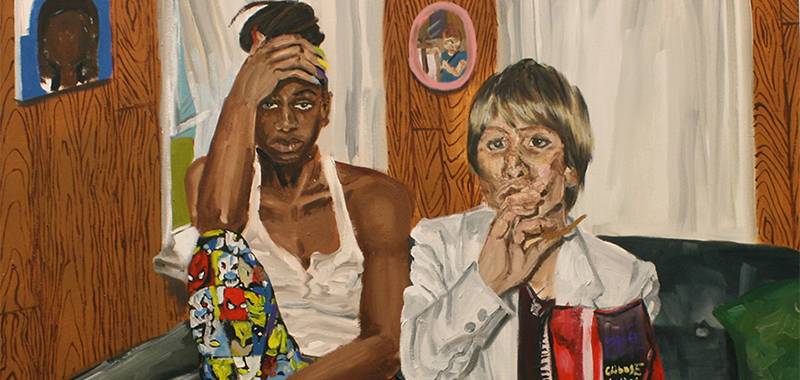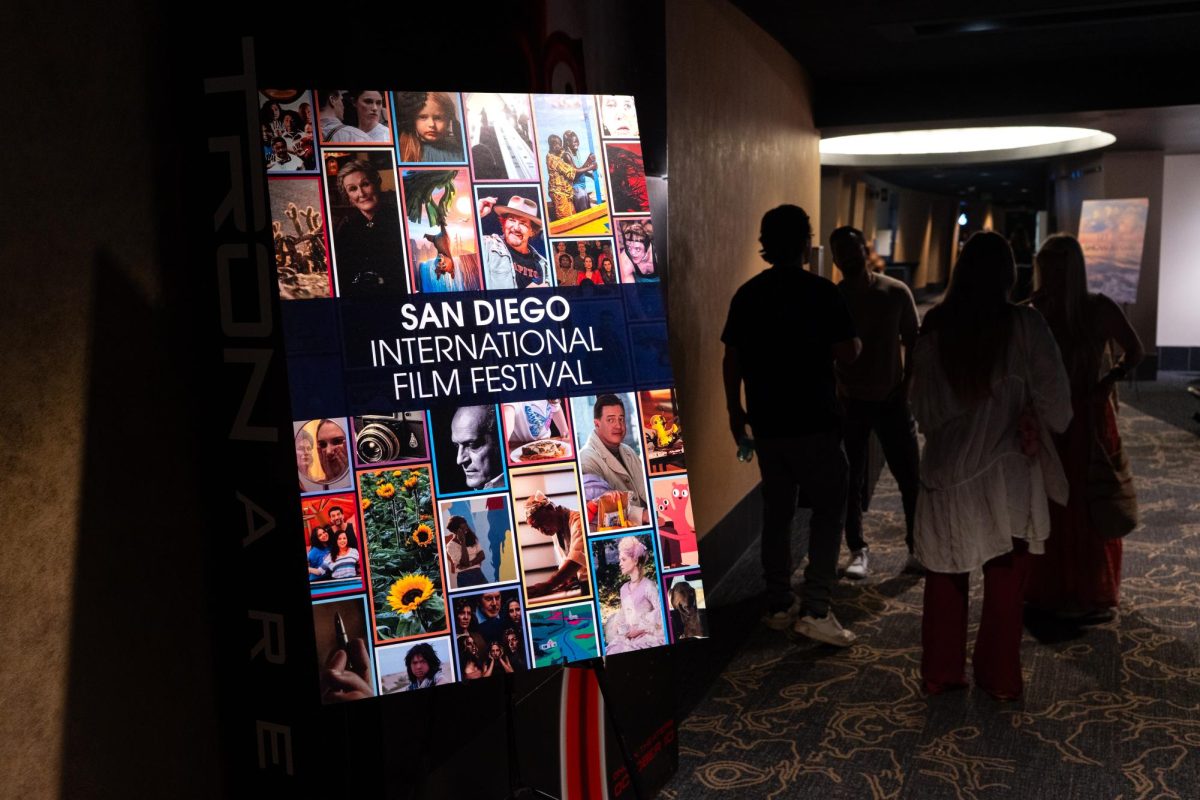Content Warning: sexual assault, sexual abuse, rape.
On May 4, 2019, the UC San Diego Visual Arts department displayed MFA student Bailey Davenport’s exhibit, an art installation called “Testify!” that honored the brave contributions of 12 survivors of sexual assault. The exhibition included five large-scale portrait paintings featuring multiple women who are all survivors of sexual assault, including Tarana Burke, Dr. Christine Blasey Ford, Stacey Lannert, Alyssa Milano, Rose McGowan, Roxsana Hernandez, Josefina Rivera, Cece McDonald, Chelsea Manning, Mary Vincent, Anita Hill, and the artist Bailey Davenport themselves.
Davenport sat down with the UCSD Guardian to discuss their artwork and what it means in a current political and social climate that silences the voices of those brave enough to speak out against sexual violence. Sexual assault is an ongoing issue and Davenport seeks to highlight the contributions of survivors, honoring their bravery in the face of stigmatization and scrutiny.
Davenport, themselves a survivor of childhood sexual abuse, has witnessed firsthand the backlash of speaking out. After disclosing to their family that their father had been abusing them, Davenport was met with ostracization, prompting them to leave their home and channel their experiences into their art once they began graduate school at the University of Tennessee, Knoxville. They began to paint about their personal experiences with assault, but the university did not support their artistic endeavors.
“It was not met very positively. They actually told me that if I kept making work about that, they were going to cut my funding,” Davenport told the Guardian. Nonetheless, they left school and continued to paint about their experiences. Initially, their paintings portrayed solely their own experiences. As time went on, Davenport started painting in-person portraits of other survivors of sexual assault. “This is not just about me, it’s a wider issue.” Through these portraits, Davenport was able to demonstrate how sexual assault affects more people than one may think.
In the wake of Brett Kavanaugh’s hearing, in which he denied the sexual assault allegations made against him by Dr. Christine Blasey Ford, as well as the current political climate in general, Davenport began to address public figures who had spoken up about their experiences with sexual assault. Davenport’s portrait of Anita Hill and Dr. Ford was their first painting to portray survivors who had received mainstream news coverage.
“Twenty years later, we are seeing the exact same thing … It is like history repeating itself exactly and we just forgot about. So then I made a whole piece about public figures,” Davenport said regarding the similarity of the two survivors’ stories.
With this exhibit, Davenport approaches the issue of sexual assault and violence through an intersectional lens, acknowledging women of color and transgender women who are oftentimes not discussed in mainstream media. Davenport always contemplates the implications of race and gender when approaching their work. “I think sexual violence is of course about gender, like a broader gender-based violence, but gender and race are inextricably linked. A lot of races are gendered, in our wider cultural thinking of it … [Marginalized groups] are gendered in those ways as a method of exploitation and I think sexual violence and racial violence are part in parcel of each other,” they said. Davenport showcases these complex dynamics through the portraits. Davenport even dedicated the exhibit to Roxsana Hernandez, a trans r woman who entered the U.S. at the San Ysidro port of entry to seek asylum after being gang-raped in Honduras. She was eventually detained by U.S Immigration and Customs Enforcement and died from dehydration and HIV-related complications. Davenport had initially seen Roxsana’s story on Facebook. They felt it was important to share Roxsana’s story due to a lack of mainstream media coverage of not only Roxsana’s experience but of other trans people who were seeking asylum alongside her. Davenport discussed the violence Roxsana was subject to, stating that “punishing someone [law enforcement] may have perceived as a man for breaking out of their gender, and how that is seen as a threat to binary gender codes,” highlighting how violence disproportionately affects trans women of color. Using an intersectional lens is important in order to understand how multiple forms of oppression can influence how a person experiences violence and marginalization, including sexual violence.
With sexual assault being such a prevalent issue on college campuses, Davenport states that compared to how their last university dealt with sexual assault “UCSD is much better, but it is such a low standard. More can always be done, especially in terms of creating a safe culture for survivors.” When dealing with sexual assault on a college campus, the institution has a responsibility to address the issue. In regards to survivors, Davenport states that universities should strive towards acknowledging the experiences of survivors and supporting them. “Show your support as opposed to silencing them so that [the university] doesn’t look bad,” Davenport said.
When trying to destigmatize sexual assault, Davenport believes that disclosure is a major step towards ending the slander. “Although it is a complicated thing, I am a big proponent of disclosure.” Davenport disclosed their abuse at the age of 24. “A lot of times when you do disclose, you are punished,” Davenport told the Guardian. Punishment manifests in multiple ways like ostracization, slut-shaming, and being blamed for their abuse. Davenport’s initial fear when disclosing their experience was based on the idea that people would think that “it’s not safe for me to be around children because I was abused as a child.” While Davenport agrees choosing to disclose is a personal decision that should be made once someone feels comfortable and safe to share their story, they think that disclosing could help end rape culture. “Rape culture thrives in the shadows, in the silences, in the cover-ups … and the burden lies on the survivors to come forward which is [s—–] … but I’ve never regretted it.” Having conversations about issues like sexual assault can be uncomfortable, but it is about leaning into that discomfort and confronting the culture that perpetuates this cycle of abuse. “As long as you are helping them keep the secret, they can control you through that fear. My dad doesn’t have that power over me ever since I disclosed,” Davenport said.
Movements such as the #MeToo movement, founded by Tarana Burke, have allowed society to address these issues and have these types of conversations that were once so taboo. In one of their paintings, Davenport depicts Tarana Burke alongside Alyssa Milano and Rose McGowan, both well known for their public accusations of rape against Hollywood media mogul Harvey Weinstein. Davenport also had comments about the movement itself. “What it comes down to is the people who come forward, and whether we keep coming forward and supporting each other while providing a safe place to speak.” Paintings are a pretty effective way to contribute to the conversation, especially when they are of such prominent and recognizable figures, reminding people that sexual assault can affect anyone, even those who are in positions of power. “Being a painter is a good medium. It is hard to ignore a painting when you’re in a room with it,” Davenport said.
With this exhibit, Davenport wanted to provide a space where survivors, whether they disclosed or not, felt heard, supported and not alone, even if for only a second. “Abusers make you feel like you’re the only one in the world, but you are not,” Davenport said.
Davenport sheds a light on an important issue, using their talents and positionality to not only share their own story, but the story of other brave women who have come forward about their experiences. These paintings serve as a reminder that there is still a long way to go in the fight for women’s autonomy over their bodies and justice for survivors. However, these women have made important strides in the destigmatization of sexual assault and we as a society must do good by them and continue their work by having these difficult conversations.
Image courtesy of UC San Diego Event Calendar.








